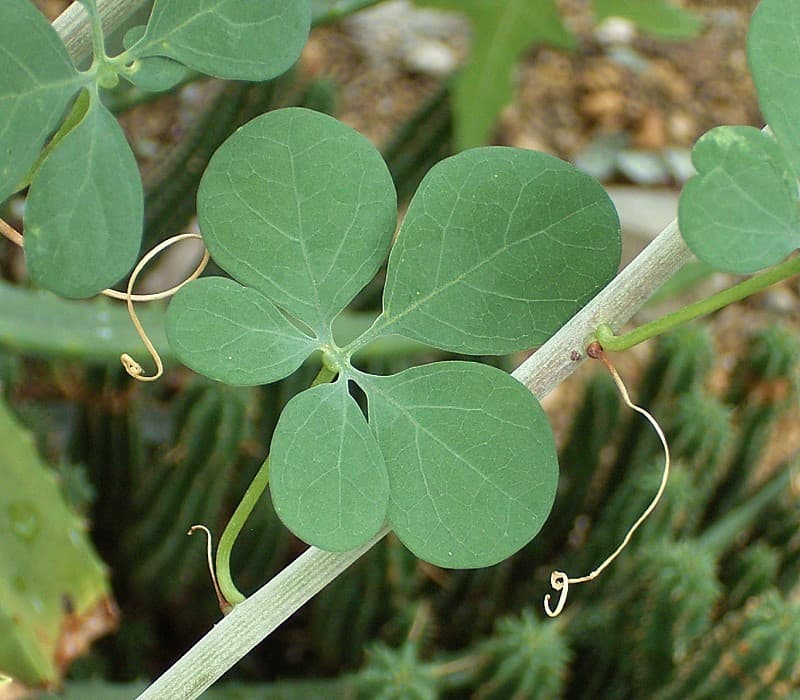Adenia fruticosa is a plant that belongs to the passionflower family, and is native to southern Africa.
This shrubby tree is around 1 to 2 m tall, but can sometimes grow up to 6 m.
The stems of Adenia fruticosa has jar-shaped and smooth, which measures between 40 to 60 cm in diameter and 1 to 2 m in height.
Its leaves are bluish-green.
Its flowers are bell-shaped, and the crown is full of fine hairs.
The leaves are almost round and are around 25 to 40 mm long and 15 to 35 mm wide.
The branches or lianas are up to 5 m in length, somewhat contorted, succulent and quite branched.
The tendrils are short and allow the plant to climb whatever is nearby.
The bark is smooth, grayish-green to yellowish-green.
The inflorescences have 2 to 5 flowers.
The male flowers have a greenish color, they measure between 13 to 15 mm long, and about 4 to 4.5 mm wide.
The petals are about 7 to 8 mm long and about 1.5 to 2 mm wide.
The female flowers are salmon-greenish to dull in color, about 7 to 8 mm long, and about 2 to 3.5 mm wide.
The sepals are 5 to 6 mm long.
The petals are 3 to 4 mm long and about 0.75 mm wide, while the crown of hairs is about 0.5 mm long.
The fruits are oval or rounded in shape, about 10 to 20 mm long, and about 8 to 18 mm in diameter, and also have smooth and leathery skin.
The seeds found in the fruits are approximately 6 to 6.5 mm long, 6 to 6.5 wide, and 2.5 mm thick.
You may like: Adenia glauca
Adenia fruticosa Care
Follow these steps, and you won’t have any issue with the
Care of your succulent plant.
Illumination
Adenia fruticosa can grow quite well in full sun or partial shade.
Something curious about this plant is that the Adenia fruticosa likes to be in the shade, while the leaves like to be in the sun.
One recommendation is to protect your plant during the sunniest summer hours to prevent the leaves from burning.
Substratum
A very porous substrate is needed; you can add a universal substrate: pumice, vulcanite, and perlite to improve drainage.
If you don’t want to get too complicated with the substrate, you can buy a substrate for cacti and succulents, as they do very well.
Propagation
The best way to propagate your Adenia fruticosa is through seeds, since propagation by cuttings is possible, but usually, the plant does not produce a caudex.
If you want the plant to produce seeds, the best way to propagate them is from cuttings since they bloom more freely.
But if you want the plant as decoration, it is best to grow them from seeds, since they develop a caudex.
Watering
This plant should be watered with some regularity in summer, while in winter, it is best to keep the soil dry as much as possible to prevent the plant from rotting easily.
Also, this beautiful plant does not like to be watered a lot when it has no leaves.
Pests or diseases
The main problem with adenia is root rot when overwatered.
During spring and summer, keep taking care of your plant to prevent it from getting sick from some very common pests at this time of year.
Fertilization
You can fertilize your plant during the active growing season, that is, during spring and summer.
You only have to apply a specific fertilizer for cacti and succulents once every 2 to 3 weeks.
During the fall and winter, suspend fertilization; at this time, the plant does not need to be fertilized.
What you can do is add some fungicide during the winter (it can even be homemade) to prevent the appearance of fungi.
Temperature
These plants appreciate warm, sunny climates.
They tolerate high temperatures quite well.
The ideal temperature for this plant is approximately 70ºF (21ºC).
If you have your plant in a pot, it is best that you keep your Adenia fruticosa inside your home during the autumn and winter months, all with the purpose of protecting it from extreme cold.
If the temperature where you live is not lower than 60ºF (15ºC), you can have it outside, while if the temperature is below 44ºF (6ºC), it is best to have it inside.
Transplant
If you have your plant in a pot, it is best to transplant it every two or three years.
If you notice that the roots are coming out of the drainage hole, it is time to transplant.
Make sure that the new pot has a drainage hole; you can also take the opportunity to add some slow-release fertilizer to strengthen your plant.
Pruning
You don’t have to prune Adenia fruticosa as regularly.
You just have to remove those leaves that are already wilted, to give the plant a more beautiful appearance and maintain its health.
Toxicity
This plant’s sap is poisonous, so you should handle the plant with caution, especially when pruning or transplanting your Adenia fruticosa.
You should also be careful with thorns, as they can be dangerous.
